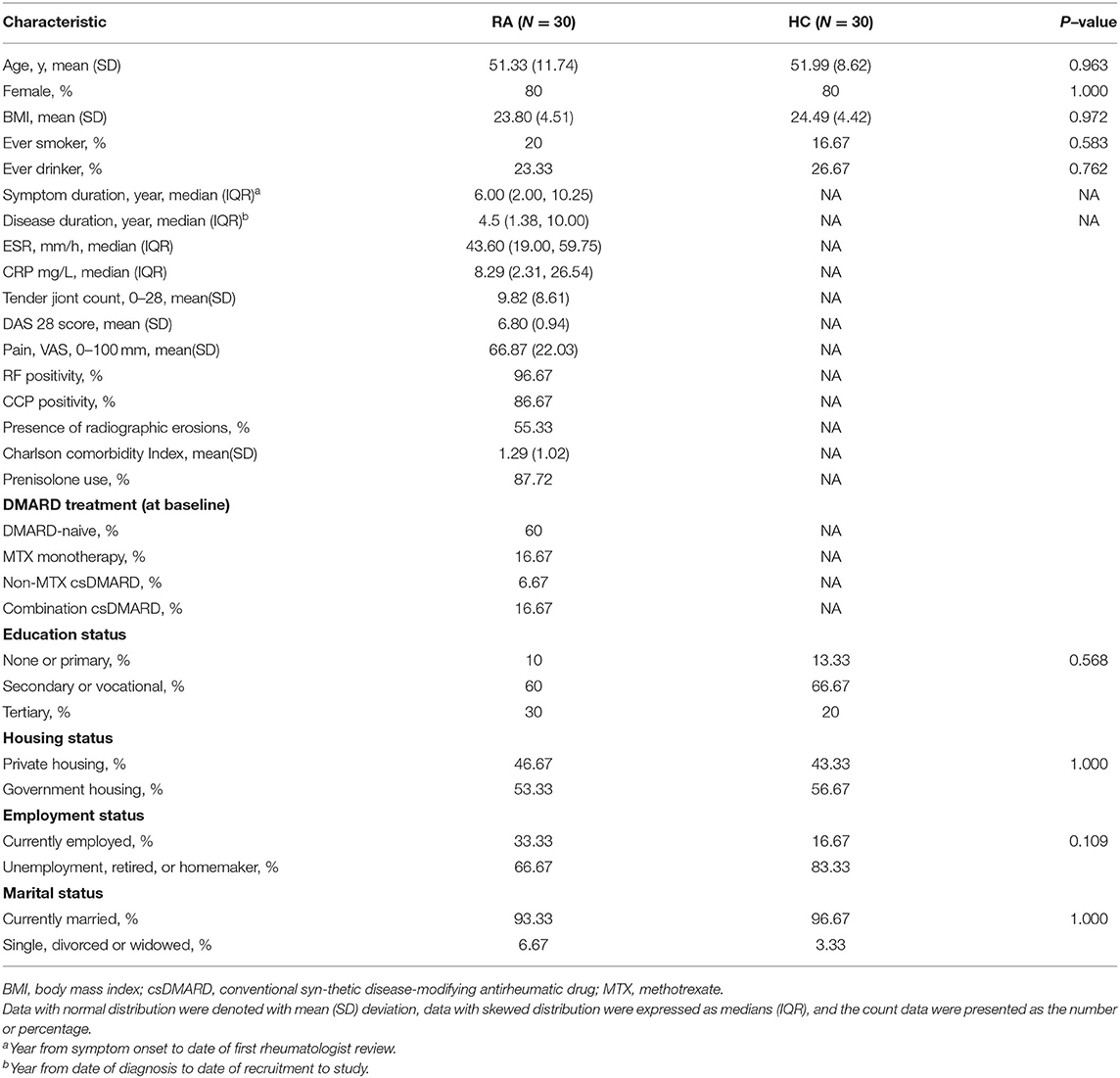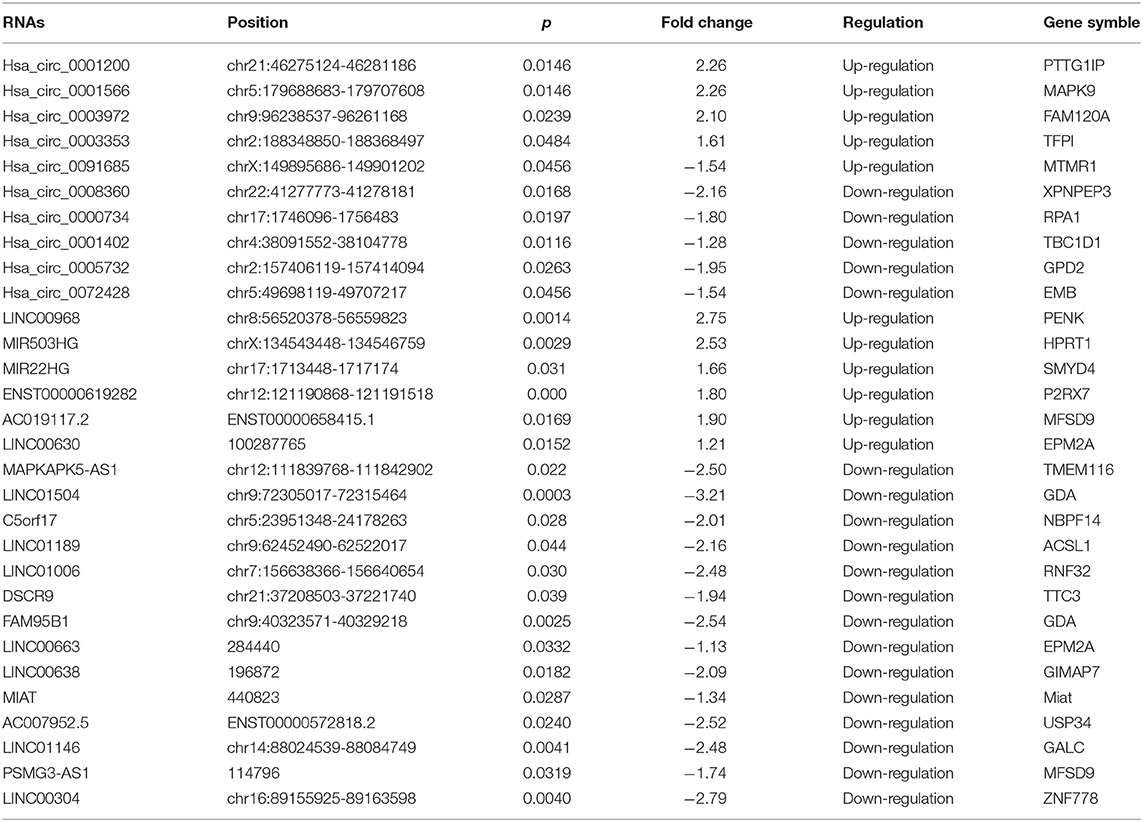- 1Anhui University of Traditional Chinese Medicine, Hefei, China
- 2Department of Rheumatology and Immunology, First Affiliated Hospital of Anhui University of Traditional Chinese Medicine, Hefei, China
- 3Institute of Rheumatology, Anhui Academy of Traditional Chinese Medicine, Hefei, China
- 4School of Electrical and Information, Anhui University of Technology, Ma'anshan, China
Self-perception in patients is their self-response to sensory stimuli. It is an important aspect of the existence and quality of life among patients. However, the inherent relationship between self-perception and the cellular activity at the molecular level is elusive. In this study, we aimed to explore the association of self-perception with RNA expression profile in patients with rheumatoid arthritis (RA) through computational analysis. We recruited 30 patients clinically diagnosed with RA and to age- and sex-matched controls without previous clinical history. In total, 5 self-perception measures and 30 RNA expression measures were derived from RA patients and control groups. A correlation analysis based on Spearman correlation and Logistic-regression methods was adopted to assess the correlation between self-perception and RNA expression. Quantitative analysis revealed that RA patients with poor self-perception were closely associated with RNAs expression, In addition, 3 key molecules including AC019117.2, LINC00638, and hsa_circ_0003972 could be used to predict self-perception changes in RA patients. Herein, our results will provide new insights in RA diagnosis however, the underlying mechanisms need to be further explored.
Introduction
Rheumatoid arthritis (RA) is an inflammatory disease characterized by chronic synovial inflammation and progressive joint destruction (1, 2). The disease has a high morbidity and mortality rate affecting ~1% of the global population (3). In the long-term, RA left untreated, causes disability of body joints hence limits their functions, reduces workability, and more importantly, deteriorates quality of life. In particular, the relationship between self-perception and therapy among self-perception patients has attracted more attention in clinical research (4). Currently, the Disease Activity Score in 28 joints (DAS28), the Visual Analog Scale (VAS), the Self-rating Depression Scale (SDS), the Self-rating Anxiety Scale (SAS) and the MOS 36-Item Short Form Survey (SF-36) have been recommended internationally to evaluate self-perception in RA patients. Therefore, they have been the most accepted evaluation methods by the majority of clinicians (5). A previous study found that 80% of RA patients with depression exhibited a highly significant correlation of depressive symptoms with RA disease activity (6). Further, our previous studies revealed that self-perception was closely related to disease activity indices such as ESR, RF, CRP, IgG in RA patients. Thus, it is suggested that a higher RA disease activity results in poorer self-perception among patients (7, 8).
There is a clear genetic basis to RA but its underlying mechanisms remain unknown (9). Recently, an increasing number of studies have attempted to reveal the important role of epigenetics in the pathogenesis of RA (10, 11). Circular RNAs (circRNAs) and long non-coding RNA (lncRNA), a novel type of endogenous non-coding RNA recently rediscovered (12, 13), are known to modulate the activity of interacting proteins or act as miRNA sponges. Specifically, they competitively associate with miRNAs, which regulate protein-coding gene expression at transcriptional and post-transcriptional levels (14, 15). Previous studies have demonstrated that circRNAs and lncRNAs are involved in regulating the pathogenesis of many diseases. Circular RNA TTBK2 regulates cell proliferation, invasion, and ferroptosis via miR-761/ITGB8 axis in glioma (16) whereas, long non-coding RNA LINC01503 promotes gastric cancer cell proliferation and invasion by regulating Wnt signaling (17). Based on the findings, these RNAs may advance the diagnosis of RA disease in the future. A recent study based on microarray analysis reported that hsa_circ_0000396 and hsa_circ_0130438 are a potential biomarker in the diagnosis of RA (18). Previously, our research showed that hsa_circ_0001200, hsa_circ_0001566, hsa_circ_0003972, and hsa_circ_0008360 are closely related to RA disease severity similar to DAS28 evaluation method (19). However, little information is known about the relationship between self-perception in RA patients and RNA expression.
In this work, we conducted a self-perception questionnaire survey among 30 RA patients and 30 healthy controls. Our main aim was to identify RNAs profiling at peripheral blood mononuclear cells (PBMCs) in RA patients and to explore the relationship between self-perception changes and RNA expression. Notably, based on the findings we identified differentially expressed RNAs in RA patients and the healthy controls via high-throughput sequencing technology, which could be used to predict SPP.
Materials and Methods
Clinical Data and Patient Samples
In total, 30 patients diagnosed with RA at the Department of Rheumatology and Immunology in the First Affiliated Hospital of Anhui University of Traditional Chinese Medicine from June 2019 to December 2019 served as RA group. In addition, 30 age- and sex-matched healthy subjects who underwent routine physical examinations in the same hospital during the same period were used as the healthy control group. The healthy controls had no clinical history of tumors, trauma, infectious diseases, or autoimmune diseases. All patients fulfilled the 2010 American College of Rheumatology/European League Against Rheumatism (ACR/EULAR) criteria for RA classification (20). However, patients with malignant tumors, severe liver, and kidney dysfunction, or pregnant women were excluded.
All the study subjects filled in the DAS28, VAS, SAS, SDS, and SF-36 under the guidance of clinical doctors. SF-36 consists of 8 dimensions namely physical functioning (PF), role physical (RP), body pain (BP), general health (GH), vitality (VT), social functioning (SF), role emotional (RE), and mental health (MH).
All clinical measurements were performed by the clinical laboratory staff in our hospital. The clinical laboratory data such as erythrocyte sedimentation rate (ESR), high-sensitivity C-reactive protein (CRP), rheumatoid factor (RF), anti-cyclic citrullinated peptide antibody (CCP), immunoglobulins A (IGA), immunoglobulin G (IGG), immunoglobulin M (IGM), complement 3 (C3), and complement 4 (C4) together with clinical characteristics were determined. This study was approved by the ethics committee from our hospital, and all participating patients provided written informed consent.
High-Throughput Sequencing and Bioinformatics Analysis
Here 3 individuals (2 females and 1 male, 45–67 years of age) diagnosed with RA following the 2010 American College of Rheumatology (ACR) diagnostic criteria, were selected for RNA-seq. Also, 3 healthy controls (2 females and 1 male, age between 45 and 66 years) without previous clinical history were selected from the Physical Examination Center in our hospital. The 3 RA patients exhibited the active stage of the disease and showed poor self-perception. RNA library construction and RNA sequencing (RNA-seq) were performed via CutSeq Biotech Inc (Shanghai, China). The ribosomal RNA (rRNA) was isolated from total RNA using the Ribo-Zero rRNA Removal Kit (Bacteria) (Illumina) following the manufacturer′s instructions. Sequencing libraries were generated using the TruSeq Stranded emRNA Library Prep Kit (Illumina, Munich, Germany). For quantification and quality checks of the libraries, we used the BioAnalzyer 2100 system and qPCR (Kapa Biosystems, Woburn, MA). The libraries were denatured into single-stranded DNA molecules, captured on Illumina Flow Cells (Illumina), and amplified in situ as clusters. Then, the libraries were sequenced for 150 cycles following the manufacturer's instructions.
Elimination of low-quality and adaptor sequences from the raw data was performed with Cutadapt (v1.6). We used EdgeR software (v3.16.5) to normalize the data and extract differentially expressed RNAs. A P < 0.05 and absolute fold change ≥ 2.0 signified differentially expressed RNAs. Afterward, the differentially expressed RNAs were selected for GO and KEGG pathway analysis.
PBMC Preparation and Total RNA Extraction
Exactly 5 mL of whole blood was drawn from RA patients and healthy controls. Thereafter, the PBMCs were isolated through Ficoll–Paque density gradient centrifugation (GE Healthcare, Uppsala, Sweden). The concentration of cells was adjusted to 5–7 × 106 cells per ml and reserved at −80°C until use.
Validation With Real-Time qPCR
Total RNA from PBMCs of the 60 samples was extracted using Trizol reagent (Invitrogen Life Technologies, Carlsbad, CA, USA) following the manufacturer's instructions. The RNA was then reverse-transcribed to single-stranded cDNA and used as a template to synthesize the second cDNA strand. Aliquots of total RNA samples were used to determine the RNA concentration and purity using the NanoDrop ND-1000 spectral photometer (peqlab). The RNAs were selected based on a combination of p-value, fold change, raw intensity, and type. In addition, RNAs with miRNA response elements (MREs) related to RA reported in previous literature were selected preferentially. Eventually, 30 RNAs were selected, including 10 circRNAs and 20 lncRNAs. All qPCR assays were performed via the Viia7 Real-Time PCR System, each sample was replicated three times. Library quality was assessed using the Agilent Bioanalyzer 2100 system. The relative expression levels of RNAs were calculated using the 2−ΔΔCt method. All primer sequences were designed at NCBI database through primer blast in the available sequences of these genes. Primer sequences were summarized and GAPDH was set as internal reference (Table 1).
Statistical Analysis
All statistical data were analyzed using SPSS version 23.0 (SPSS, Chicago, IL) statistical package and GraphPad Prism 8.0 (GraphPad; LaJolla, CA). Descriptive data were represented as the mean ± standard deviation for normally distributed variables whereas, data for non-normally distributed variables were represented as median (25–75%). Univariate descriptive statistics were used to describe the sample X2 tests performed for categorical variables. Further, continuous variables were evaluated using t-tests or Mann-Whitney non-parametric tests, as appropriate. Spearman Correlation test and Logistic Regression analysis were adopted for correlation analysis to identify statistically significant RNAs, clinical indices associated with self-perception in RA patients. A p-value of p < 0.05 was statistically significant (*p < 0.05, **p < 0.01, ***p < 0.001).
Results
General Characteristics of the Study Population
The baseline characteristics of RA patients and healthy controls can be found in Table 2. There were 28 (80%) females with mean age 51.33 (SD = 11.74) years in the RA group, and 28 (80%) females with mean age 51.99 (SD = 8.62) years in the healthy control group. There was no significant difference in mean age and gender between the two groups. Besides, there were no differences in employment, housing or marital status at baseline.
Differentially Expressed RNAs in the PBMCs of RA Patients
The differentially expressed RNAs between the RA group and healthy control groups with statistical criteria were determined through fold change and p-value (p-value < 0.05 absolute fold change ≥2.0). A total of differentially expressed 165 circRNAs, 341 lncRNAs, 63 miRNAs, and 7,895 mRNAs were identified. In contrast to the healthy control group, a total of 109 circRNAs from the RA group were significantly upregulated, and 56 significantly downregulated as shown by a volcano plot (Figure 1A) and a cluster heatmap (Figure 1B). A total of 231 lncRNAs were significantly upregulated, and 110 were significantly downregulated in the RA group as shown by a volcano plot (Figure 1C) and a clustered heatmap (Figure 1D). In the RA group, 52 miRNAs were markedly upregulated, whereas 11 miRNAs were significantly downregulated as depicted in the volcano plot (Figure 1E) and cluster heatmap (Figure 1F). In total, 4,916 mRNAs were strikingly upregulated, and 2,934 significantly downregulated in the RA group as shown by a volcano plot (Figure 1G) and a cluster heatmap (Figure 1H).
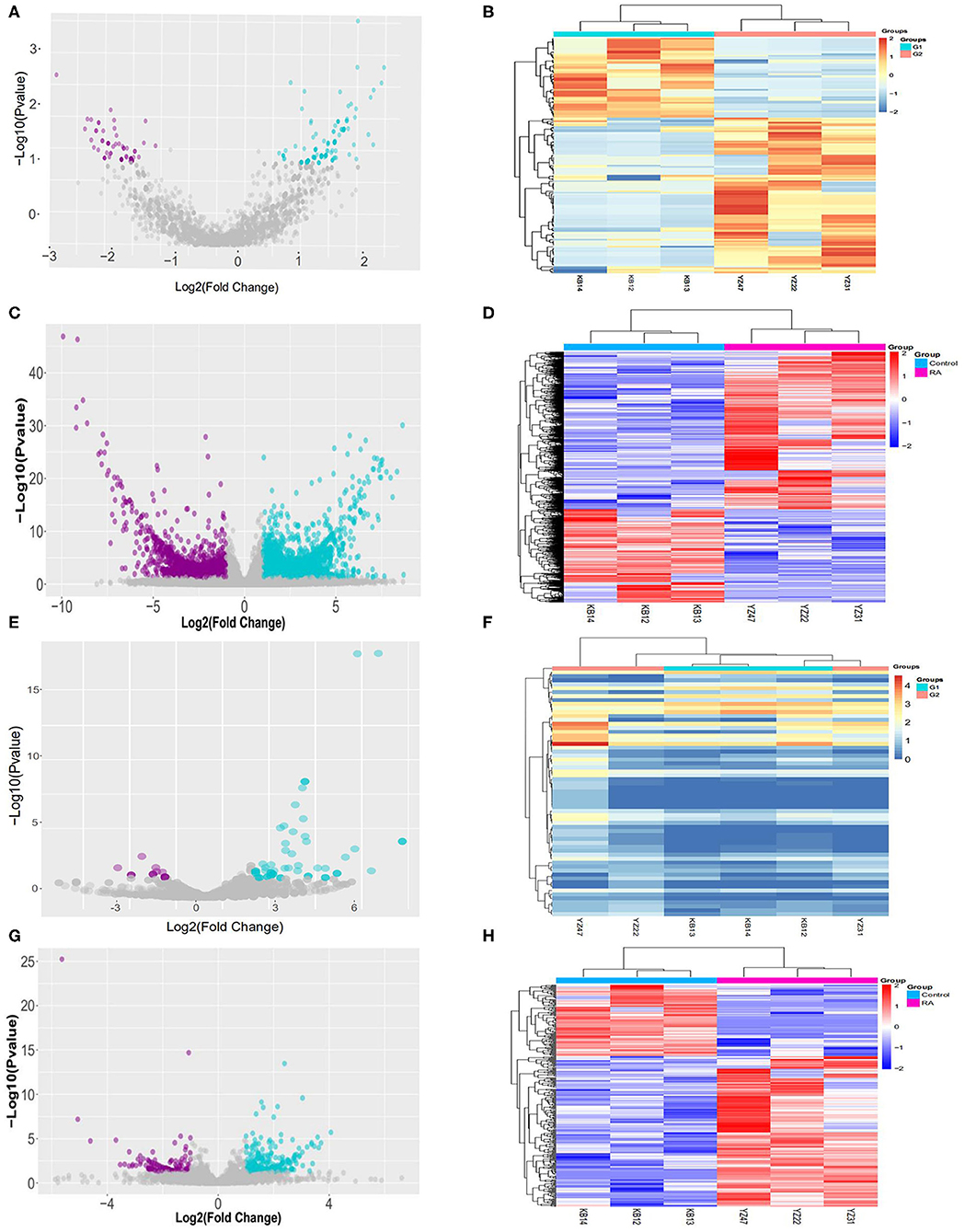
Figure 1. Sequences determining the RNA expression profiles in RA patients and healthy controls. (A) Volcano plot of circRNAs. The vertical lines correspond to 1.5-fold up and down while the horizontal line represents a P-value of 0.05. (B) Heatmap of differentially expressed circRNAs. Red: high relative expression; blue: low relative expression. (C) Volcano plot of lncRNAs. The vertical lines correspond to 1.5-fold up and down and the horizontal line represents a P-value of 0.05. (D) Heatmap of differentially expressed lncRNAs: Red: high relative expression; blue: low relative expression. (E) Volcano plot of miRNAs: The vertical lines correspond to 1.5-fold up and down and the horizontal line represents a P-value of 0.05. (F) Heatmap of differentially expressed miRNAs: Red: high relative expression; blue: low relative expression. (G) Volcano plot of mRNAs: The vertical lines correspond to 1.5-fold up and down and the horizontal line represents a P-value of 0.05. (H) Heatmap of differentially expressed mRNAs: Red: high relative expression; blue: low relative expression.
Function of Differentially Expressed circRNAs and mRNAs in RA Patients
To explore the differentially expressed circRNAs and mRNAs, we performed Gene Ontology (GO) terms, Kyoto Encyclopedia of Genes and Genomes (KEGG), and functional enrichment analyses. The results revealed that the differentially expressed circRNAs were associated with the top two enriched biological processes including organelle organization and positive regulation of cytoplasmic mRNA processing. The top two enriched cellular components include intracellular and intracellular components whereas the top two enriched molecular functions are catalytic activity and heterocyclic compound binding (Figure 2A). The analysis results showed that the differentially expressed mRNAs contained the top two enriched biological processes: organelle organization and protein modification by small protein conjugation, the top two enriched cellular component: intracellular and intracellular part, the top two enriched molecular function: cytoplasm and catalytic activity (Figure 2C). Furthermore, the top 20 pathways connected with circRNAs and mRNAs function in the RA group were defined by the KEGG analysis. Both bacterial invasion of epithelial cells and the cAMP signaling pathway were the top two in circRNAs and mRNAs functions (Figures 2B,D).
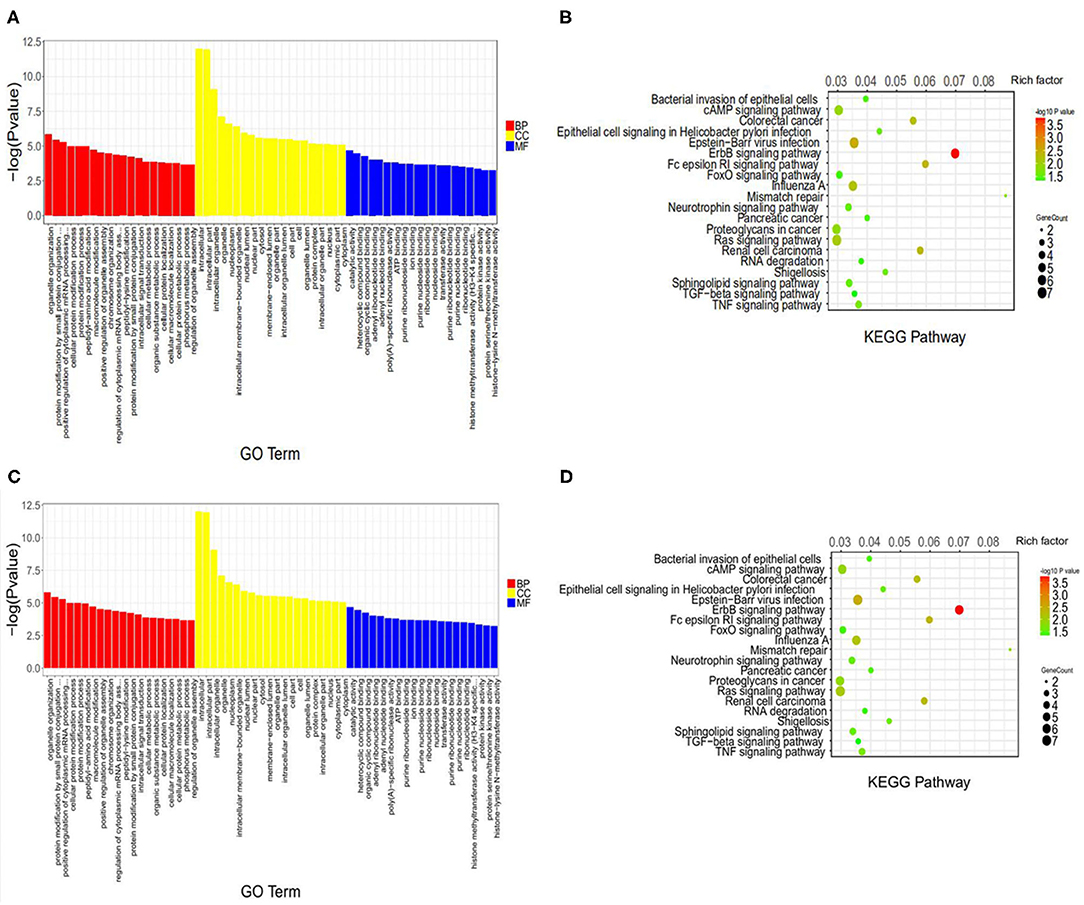
Figure 2. GO analysis and KEGG pathway annotation of differentially expressed RNAs. (A,C) The top 20 significant changes in GO biological process classification of circRNAs and mRNAs. Red, yellow, and blue bars represent biological Process, cellular component, and molecular function, respectively. (B,D) The top 20 significant changes in the KEGG pathway classification of circRNAs and mRNAs. The bar plot shows the top Enrichment Score [–log10 (P-value)] of the significant pathway. The color represents the level of differences, a darker color indicates a greater difference. The circle represents the relationship.
Basic Characteristics of Selected RNAs
A total of 30 differentially expressed genes were screened in the RA group (Table 3). Out of these, 10 differentially expressed circRNAs including 5 upregulated and 5 downregulated genes were selected. However, 20 differentially expressed lncRNAs including 5 upregulated and 15 downregulated genes were selected (Table 3).
Verification of Selected RNAs
PBMCs from 30 RA patients and 30 healthy controls were used for verification through RT-qPCR. On the base of sequencing, we selected 30 RNAs from the most significant RNAs for further verification. Among the selected 30 RNAs, the expression levels of MIR503HG, LINC00630, hsa_circ_0001566, hsa_circ_0003972, hsa_circ_0003353 (p < 0.001), MIR22HG, ENST00000619282, hsa_circ_0001200 (p < 0.01), LINC01006, AC019117.2, hsa_circ_0091685 (p < 0.05) were significantly high in the RA group than in the healthy group (Figures 3A–F, P–T). Additionally, the expression levels of LINC00304, LINC01504, FAM95B1, AC007952.5, hsa_circ_0005732 (p < 0.001), LINC01189, DSCR9, LINC00638, hsa_circ_0008360, hsa_circ_0072428 (p < 0.01), MAPKAPK5-AS1, LINC00663 (p < 0.05) were significantly low in the RA group compared to the healthy group (Figures 3G–O,U–W).
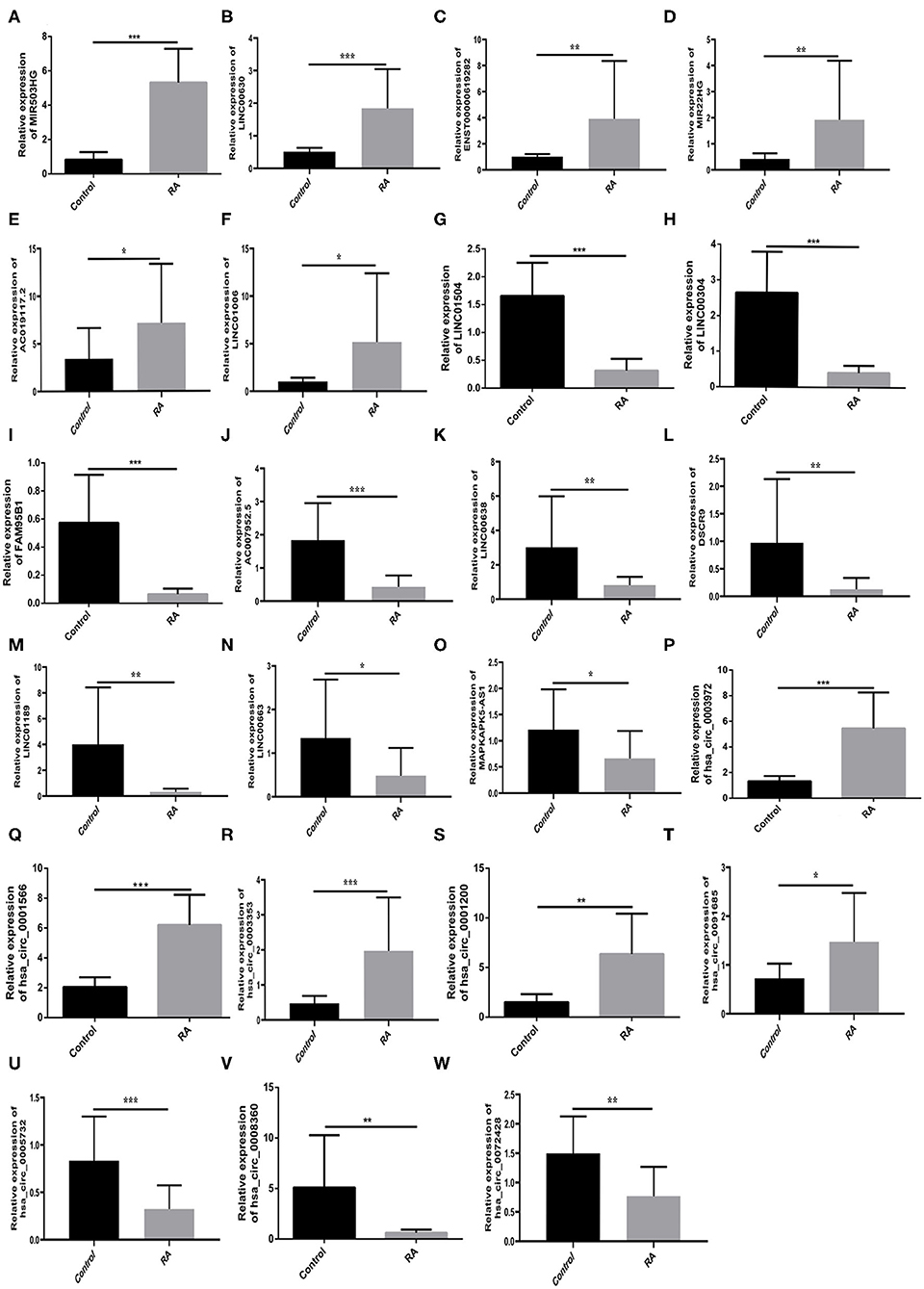
Figure 3. Quantitative RT-qPCR determines the relative expression levels of RNAs. (A–F,P–T) MIR503HG, LINC00630, hsa_circ_0001566, hsa_circ_0003972, hsa_circ_0003353 (p < 0.001), MIR22HG, ENST00000619282, hsa_circ_0001200 (p < 0.01), LINC01006, AC019117.2, hsa_circ_0091685 (p < 0.05) exhibited the same increasing trend as the sequencing results. (G–O,U–W) LINC00304, LINC01504, FAM95B1, AC007952.5, hsa_circ_0005732 (p < 0.001), LINC01189, DSCR9, LINC00638, hsa_circ_0008360, hsa_circ_0072428 (p < 0.01), MAPKAPK5-AS1, LINC00663 (p < 0.05) exhibited the same decreasing trend as the sequencing results. *p < 0.05, **p < 0.01, and ***p < 0.001 vs. control.
Spearman Correlation Analysis of Self-Perception, RNA Expression, and Clinical Indices in RA Patients
We analyzed the relationship between the expression of 30 validated RNAs, which reflects the quality of life, and clinical indices which reflect the severity of the disease was analyzed. We found that DAS28 correlated positively with hsa_circ_0003972 and hsa_circ_0005732 and AC019117.2, while correlated negatively with ESR, CRP, RF, CCP (Figures 4A–G). In addition, VAS correlated positively with LINC00638 AC019117.2, and IGM (Figures 4H–J). SAS positively correlated with AC019117.2 and negatively with ENST00000619282 (Figures 4K,L). SDS correlated positively with AC019117.2 and LINC01189 (Figures 4M,N). Furthermore, PF correlated positively with hsa_circ_0005732, DSCR9, and negatively with AC019117.2 RF (Figures 4O–R). RP correlated negatively with hsa_circ_0003353, LINC00638, and AC019117.2 (Figures 4S–U). BP correlated positively with AC019117.2 and negatively with CRP (Figures 4V,W). GH correlated positively with hsa_circ_0072428, negatively with LINC00638, CRP (Figures 4X–Z). VT correlated negatively with AC019117.2 and LINC00638 (Figures 4AB,AC). Moreover, SF correlated positively with ENST00000619282, AC019117.2, and LINC00638, negatively with LINC01189 (Figures 4AD–AG). MH correlated positively with hsa_circ_0005732, LINC01189, DSCR9 (Figures 4AH–AJ) whereas RE correlated positively with DSCR9 and negatively correlated with AC019117.2 (Figures 4AK,AL).
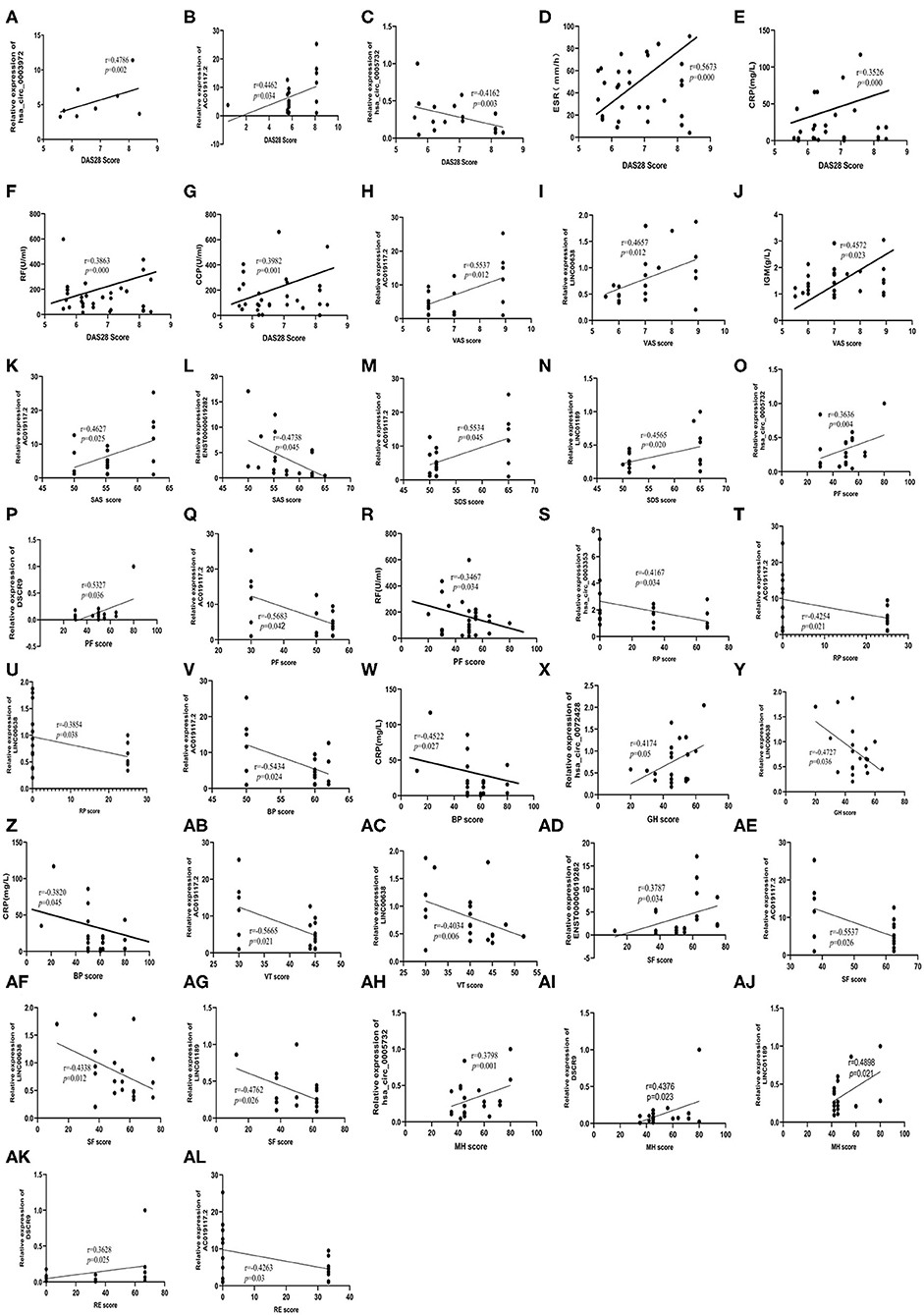
Figure 4. Correlation between SPP and RNAs, clinical indexes. (A–G) DAS28 score correlated positively with hsa_circ_0003972, hsa_circ_0005732, AC019117.2, and correlated negatively with ESR, CRP, RF, and CCP. (H–J) VAS score correlated positively with LINC00638, AC019117.2, and IGM. (K,L) SAS score correlated positively with AC019117.2 and correlated negatively with ENST00000619282. (M,N) SDS score correlated positively with AC019117.2, LINC01189. (O–R) PF score correlated positively with hsa_circ_0005732, DSCR9, and correlated negatively with AC019117.2, RF. (S–U) RP score correlated negatively with hsa_circ_0003353, LINC00638, AC019117.2. (V,W) BP score positively correlated with AC019117.2 and correlated negatively with CRP. (X–Z) GH score positively correlated with hsa_circ_0072428, a negatively correlated with LINC00638, CRP. (AB,AC) VT score negatively correlated with AC019117.2, LINC00638. (AD–AG) SF score correlated positively with ENST00000619282, AC019117.2, LINC00638, and negatively correlated with LINC01189. (AH–AJ) MH score correlated positively with hsa_circ_0005732, LINC01189, DSCR9. (AK,AL) RE score positively correlated with DSCR9, and correlated negatively with AC019117.2.
Logistic Regression Analysis of Self-Perception Related Factors
Logistic Regression analysis of risk factors in self-perception among RA patients was carried out. Significant difference in DAS28 were found between RA patients with hsa_circ_0003972 (Wald Chi-square value = 15.782, potence ratio: 2.891, P = 0.009), AC019117.2 (Wald Chi-square value = 9.930, potence ratio: 3.782, P = 0.021),ENST00000619282 (Wald Chi-square value = 3.349, potence ratio: 3.821, P = 0.027),DSCR9 (Wald Chi-square value = 12.341, potence ratio: 5.673, P = 0.034),ESR (Wald Chi-square value = 8.563, potence ratio: 4.672, P = 0.002),indicating that these RNAs are risk factors for DAS28. Therefore, higher RNA expression levels implied a higher DAS28 score (Table 4). Additionally, we found a significant difference in the VAS score in RA patients with LINC00638 (Wald Chi-square value = 3.441, potence ratio: 1.243, P = 0.026) and AC019117.2 (Wald Chi-square value = 4.893, potence ratio: 2.784, P = 0.038), indicating that they are risk factors for VAS. Hence, the higher the RNAs expression, the higher the VAS score (Table 5). Furthermore, a significant difference in SAS was found in RA patients with hsa_circ_0003353 (Wald Chi-square value = 4.628, potence ratio: 2.753, P = 0.034), MAPKAPK5-AS1 (Wald Chi-square value = 3.572, potence ratio: 1.563, P = 0.047), indicating that these are risk factors for SAS. This implies that the higher the RNAs expression, the higher the SAS score (Table 6). In addition, significant differences in GH were found in RA patients with hsa_circ_0072428 (Wald Chi-square value = 7.523, potence ratio: 2.754, P = 0.012), indicating that hsa_circ_0072428 is a risk factor for GH, thus, the higher RNA expression, the lower the GH score (Table 7).
Discussion
In this study, we filtered 30 RNAs with differential expression that were validated by RT-qPCR technique. The results showed that 27 exhibited the same trends as the sequencing results. Through Spearman correlation analysis we demonstrated that 9 out of 27 genes had a significant correlation with self-perception in RA patients. Further Logistic Regression analysis of RNA expression revealed that. AC019117.2, LINC00638, hsa_circ_0003972 were the strong risk factors for self-perception. Besides, the key RNAs associated with self-perception isolated from 3 RA patients and 3 healthy people were selected and verified for RNA-sequencing. Other studies currently being conducted have identified some specific RNAs from RA patients which are associated with self-perception and clinical indicators.
RA is an autoimmune disease associated with increased depression and decreased quality of life (21, 22). Notably, immune mechanisms hold the dominant position for enhancing the possibility of RA occurrence and changes in self-perception (6). However, there is a need to identify new biomarkers and explore their functions since the details of the RA mechanisms remain ambiguous. Both CircRNAs and lncRNAs function by competing ceRNAs, also known as miRNA “sponges,” which are RNA transcripts that competitively for the binding to specific miRNAs (23). For instance, decreased hsa_circ_0044235 in PBMCs has been confirmed to have a significant efficacy in the diagnosis of RA (24). Elsewhere, a study revealed that the expression of LncRNA ENST00000456270 is strongly associated with the serum levels of IL-6, TNF-a, and the Simplified Disease Activity Index (SDAI) of the RA patient (25). In addition, FOXM1/LINC00152 feedback loop regulates the proliferation and apoptosis in rheumatoid arthritis fibroblast-like synoviocytes via Wnt/β-catenin signaling pathway (26). However, no study has analyzed the correlation between RNA expression, self-perception, and clinical indices. Several studies have observed a strong link between the disease activity and quality of life amongst RA patients, however, its development mechanisms from RNA expression perspective have not been pronounced (4). Consequently, the roles of RNAs in patients with poor self-perception are unclear. As a result, it is essential to profile RNAs expression and discover new biomarkers, which will provide a new awareness for self-perception changes in RA patients.
In the present study, we recruited 30 RA patients and 30 age- and sex-matched healthy participants who acted as controls. All of the participants filled in the DAS28, VAS, SAS, SDS, SF-36 under the guidance of clinical doctors. The results uncovered poor self-perception in RA patients compared to the healthy controls. Moreover, DAS28, VAS, SAS, SDS, ESR, CRP were significantly increased (P < 0.05), whereas PF, RP, BP, GH, VT, SF, RE, MH were significantly decreased (P < 0.05). Meanwhile, RF, CCP, IGA, IGG, IGM, C3, C4 were significantly high compared to the healthy control group (P < 0.05). We identified 3 RA patients and 3 healthy control for RNA-seq. Of note, we identified differentially expressed 165 circRNAs, 341 lncRNAs, 63 miRNAs, and 7,895 mRNAs, respectively. Besides, GO enrichment and KEGG analysis suggested that RNAs are involved in protein modification, catalytic activity, and cAMP signaling pathways. Furthermore, we increased the number of samples and carried out RT-qPCR to verify sequencing results. Subsequently, we identified 30 RNAs based on their expression distribution in each specimen. As a consequence, 11 RNAs in the RA group were significantly higher than in the healthy group whereas 12 RNAs in the RA group were significantly lower than in the healthy group. Our results provide insights into the pathomechanism of RA and a theoretical basis for the in-depth exploration of the RNAs function in RA.
Based on the results from Spearman correlation and Logistic Regression analyses, we proudly report that 3 RNAs were closely related to RA patients with poor self-perception. The 3 RNAs include AC019117.2, LINC00638, and hsa_circ_0003972. Further, Spearman correlation analysis indicated that DAS28 correlated positively with AC019117.2, hsa_circ_0003972, whereas VAS correlated positively with LINC00638. Also, Logistic Regression analysis suggested that AC019117.2 and hsa_circ_0003972 are risk factors for DAS28 and LINC00638 is a risk factor for VAS.
Of note, AC019117.2, LINC00638, and hsa_circ_0003972 may provide a new theoretical basis for research on RNAs, hence promoting the use of these RNAs as valuable biomarkers in RA patients with poor self-perception. Despite laying the key foundation in the understanding of RA pathogenesis, this study had some limitations. For instance, the potential mechanisms of the key RNAs in RA patients with poor self-perception still needs to be further elucidated. Furthermore, it is possible that the sample size was too small to detect a difference between seropositive and seronegative RA patients. Additionally, there are still some few RNAs with minimal relationship with self-perception thus deserves further exploration. In the future, the function of other differentially expressed RNAs should be confirmed in a larger sample size. Further in vitro and animal studies should be conducted to advance the comprehension of the detailed mechanisms and specific functions of RNAs in RA patients with poor self-perception.
In summary, AC019117.2, LINC00638, and hsa_circ_0003972 are potentially significant predictors in RA patients with poor self-perception. However, the mechanisms of these RNAs need to be further investigated.
Data Availability Statement
The datasets presented in this study can be found in online repositories. The names of the repository/repositories and accession number(s) can be found in the article/supplementary material.
Ethics Statement
The studies involving human participants were reviewed and approved by The Ethics Committee of the First Affiliated Hospital of Anhui University of Traditional Chinese Medicine. The patients/participants provided their written informed consent to participate in this study. Written informed consent was obtained from the individual(s) for the publication of any potentially identifiable images or data included in this article.
Author Contributions
JWe, JL, BW, HJ, LW, LX, and YuS contributed to the study design. JWe contributed to data analysis, wrote the first draft, and revised the manuscript. YaS, YZ, XD, XW, and JWa contributed to the questionnaire survey on patients, specimens, and data collection. JL and BW supervised the project and helped revise the manuscript. All authors reviewed and accepted the content of the final manuscript. All authors contributed to the article and approved the submitted version.
Funding
This work was supported by grants from Ministry of Science and Technology National Key Research and Development Program Chinese Medicine Modernization Research Key Project (2018YFC1705204); National Nature Fund Program (81973655); The Key Research and Development Program Foreign Science and Technology Cooperation Project of Anhui (201904b11020011); Anhui Provincial Quality Engineering Teaching and Research Project (2018jyxm1068); Anhui Famous Traditional Chinese Medicine Liu Jian Studio Construction Project (Traditional Chinese Medicine Development Secret [2018] No. 11); National Key Innovative Talents Training Project of Traditional Chinese Medicine (National Education Letter of Traditional Chinese Medicine [2019] No.128); Key Research and Development Plan Project of Anhui Province (201904a07020004); Anhui Provincial Laboratory of Applied Basis and Development of Internal Medicine of Modern Traditional Chinese Medicine (2016080503B041); and 12th batch of ‘115' Innovation Team of Anhui Province (Anhui Talent Office [2019] No. 1).
Conflict of Interest
The authors declare that the research was conducted in the absence of any commercial or financial relationships that could be construed as a potential conflict of interest.
References
1. Wang J, Yan S, Yang J, Lu H, Xu D, Wang Z. Non-coding RNAs in rheumatoid arthritis: from bench to bedside. Front Immunol. (2019) 20:3129. doi: 10.3389/fimmu.2019.03129
2. Firestein GS. Evolving concepts of rheumatoid arthritis. Nature. (2003) 423:356–61. doi: 10.1038/nature01661
3. Wechalekar MD, Lester S, Hill CL, Lee A, Rischmueller M, Smith MD, et al. Active foot synovitis in patients with rheumatoid arthritis: unstable remission status, radiographic progression, and worse functional outcomes in patients with foot synovitis in apparent remission. Arthritis Care Res. (2016) 68:1616–23. doi: 10.1002/acr.22887.
4. Qorolli M, Rexhepi B, Rexhepi S, Mustapić M, Doko I, Grazio S. Association between disease activity measured by RAPID3 and health-related quality of life in patients with rheumatoid arthritis. Rheumatol Int. (2019) 39:827–34. doi: 10.1007/s00296-019-04258-z
5. Oude Voshaar MAH, Das Gupta Z, Bijlsma JWJ, Boonen A, Chau J, Courvoisier DS, et al. International consortium for health outcome measurement set of outcomes that matter to people living with inflammatory arthritis: consensus from an international working group. Arthritis Care Res. (2019) 71:1556–65. doi: 10.1002/acr.23799
6. Hassan AA, Nasr MH, Mohamed AL, Kamal AM, Elmoghazy AD. Psychological affection in rheumatoid arthritis patients in relation to disease activity. Medicine (Baltimore). (2019) 98:e15373. doi: 10.1097/MD.0000000000015373
7. Zhang Y, Liu J, Huang D, Wan L, Long Y, Bao BX. Feeling changes of 135 patients with rheumatoid arthritis and related analyses. J Rheum Arthritis. (2019) 8:15–9. doi: 10.3969/j.issn.2095-4174.2019.11.003
8. Sun Y, Liu J, Fang L, Zhu FB, Tan B, Zhang PH. Study on anxiety and depression of 604 patients with rheumatoid arthritis. J Rheum Arthritis. (2016) 5:9–15. doi: 10.3969/j.issn.2095-4174.2016.09.002
9. Klareskog L, Rönnelid J, Saevarsdottir S, Padyukov L, Alfredsson L. The importance of differences; on environment and its interactions with genes and immunity in the causation of rheumatoid arthritis. J Intern Med. (2020) 287:514–33. doi: 10.1111/joim.13058
10. Karami J, Aslani S, Tahmasebi MN, Mousavi MJ, Sharafat Vaziri A, Jamshidi A, et al. Epigenetics in rheumatoid arthritis; fibroblast-like synoviocytes as an emerging paradigm in the pathogenesis of the disease. Immunol Cell Biol. (2020) 98:171–86. doi: 10.1111/imcb.12311
11. Nemtsova MV, Zaletaev DV, Bure IV, Mikhaylenko DS, Kuznetsova EB, Alekseeva EA, et al. Epigenetic changes in the pathogenesis of rheumatoid arthritis. Front Genet. (2019) 10:570. doi: 10.3389/fgene.2019.00570
12. Qu S, Yang X, Li X, Wang J, Gao Y, Shang R, et al. Circular RNA: A new star of noncoding RNAs. Cancer Lett. (2015) 365:141–8. doi: 10.1016/j.canlet.2015.06.003
13. Kazimierczyk M, Kasprowicz MK, Kasprzyk ME, Wrzesinski J. Human long noncoding RNA interactome: detection, characterization and function. Int J Mol Sci. (2020) 21:1027. doi: 10.3390/ijms21031027
14. Kulcheski FR, Christoff AP, Margis R. Circular RNAs are miRNA sponges and can be used as a new class of biomarker. J Biotechnol. (2016) 238:42–51. doi: 10.1016/j.jbiotec.2016.09.011
15. Huang Y. The novel regulatory role of lncRNA-miRNA-mRNA axis in cardiovascular diseases. J Cell Mol Med. (2018) 22:5768–75. doi: 10.1111/jcmm.13866
16. Zhang HY, Zhang BW, Zhang ZB, Deng QJ. Circular RNA TTBK2 regulates cell proliferation, invasion and ferroptosis via miR-761/ITGB8 axis in glioma. Eur Rev Med Pharmacol Sci. (2020) 24:2585–600. doi: 10.26355/eurrev_202003_20528
17. Ding J, Shi F, Xie G, Zhu Y. Long non-coding RNA linc01503 promotes gastric cancer cell proliferation and invasion by regulating Wnt signaling. Dig Dis Sci. (2020) 23:1–8. doi: 10.1007/s10620-020-06215-4
18. Yang X, Li J, Wu Y, Ni B, Zhang B. Aberrant dysregulated circular RNAs in the peripheral blood mononuclear cells of patients with rheumatoid arthritis revealed by RNA sequencing: novel diagnostic markers for RA. Scand J Clin Lab Invest. (2019) 79:551–9. doi: 10.1080/00365513.2019.1674004
19. Wen J, Liu J, Zhang P, Jiang H, Xin L, Wan L, et al. RNA-seq reveals the circular RNA and miRNA expression profile of peripheral blood mononuclear cells in patients with rheumatoid arthritis. Biosci Rep. (2020) 40:BSR20193160. doi: 10.1042/BSR20193160
20. Aletaha D, Neogi T, Silman AJ, Funovits J, Felson DT, Bingham CO III, et al. 2010 Rheumatoid arthritis classification criteria: an American college of rheumatology/European league against rheumatism collaborative initiative. Arthritis Rheum. (2010) 62:2569–81. doi: 10.1002/art.27584
21. Sidiropoulos PI, Goulielmos G, Voloudakis GK, Petraki E, Boumpas DT. Inflammasomes and rheumatic diseases: evolving concepts. Ann Rheum Dis. (2008) 67:1382–9. doi: 10.1136/ard.2007.078014
22. Croia C, Bursi R, Sutera D, Petrelli F, Alunno A, Puxeddu I. One year in review 2019: pathogenesis of rheumatoid arthritis. Clin Exp Rheumatol. (2019) 37:347–57.
23. Panda AC. Circular RNAs act as miRNA sponges. Adv Exp Med Biol. (2018) 1087:67–79. doi: 10.1007/978-981-13-1426-1_6
24. Luo Q, Zhang L, Li X, Fu B, Guo Y, Huang Z, et al. Identification of circular RNAs hsa_circ_0044235 and hsa_circ_0068367 as novel biomarkers for systemic lupus erythematosus. Int J Mol Med. (2018) 194:118–24. doi: 10.3892/ijmm.2019.4302
25. Yuan M, Wang S, Yu L, Qu B, Xu L, Liu L, et al. Long noncoding RNA profiling revealed differentially expressed lncRNAs associated with disease activity in PBMCs from patients with rheumatoid arthritis. PLoS ONE. (2017) 12:e0186795. doi: 10.1371/journal.pone.0186795
Keywords: RNAs, rheumatoid arthritis, self-perception of patient, RNA, logistic-regression analysis, spearman correlation analysis
Citation: Wen J, Liu J, Wang B, Jiang H, Wan L, Xin L, Sun Y, Sun Y, Zhang Y, Du X, Wang X and Wang J (2020) Prediction of Self-Perception of Patient in Rheumatoid Arthritis With the Key RNAs Expression Profiles. Front. Med. 7:567. doi: 10.3389/fmed.2020.00567
Received: 30 April 2020; Accepted: 11 August 2020;
Published: 18 September 2020.
Edited by:
Peter Cheung, National University Health System, SingaporeReviewed by:
Weikuan Gu, University of Tennessee Health Science Center (UTHSC), United StatesMitsuhiro Takeno, Nippon Medical School, Japan
Copyright © 2020 Wen, Liu, Wang, Jiang, Wan, Xin, Sun, Sun, Zhang, Du, Wang and Wang. This is an open-access article distributed under the terms of the Creative Commons Attribution License (CC BY). The use, distribution or reproduction in other forums is permitted, provided the original author(s) and the copyright owner(s) are credited and that the original publication in this journal is cited, in accordance with accepted academic practice. No use, distribution or reproduction is permitted which does not comply with these terms.
*Correspondence: Jian Liu, bGl1amlhbmFoenlAMTI2LmNvbQ==; Bing Wang, d2FuZ2JpbmdAdXN0Yy5lZHU=
 Jianting Wen1
Jianting Wen1 Jian Liu
Jian Liu Bing Wang
Bing Wang
